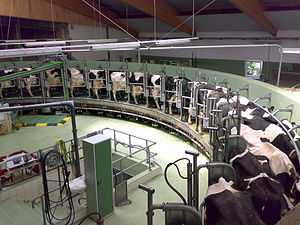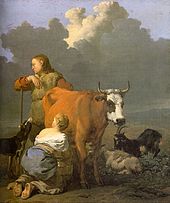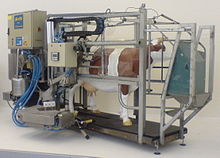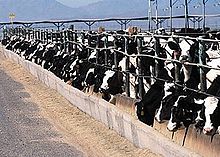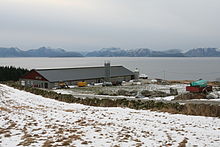
Dairy farming
About this schools Wikipedia selection
The articles in this Schools selection have been arranged by curriculum topic thanks to SOS Children volunteers. All children available for child sponsorship from SOS Children are looked after in a family home by the charity. Read more...
Dairy farming is a class of agricultural, or an animal husbandry, enterprise, for long-term production of milk, usually from dairy cows but also from goats, sheep and camels, which may be either processed on-site or transported to a dairy factory for processing and eventual retail sale.
Most dairy farms sell the male calves born by their cows, usually for veal production, or breeding depending on quality of the bull calf, rather than raising non-milk-producing stock. Many dairy farms also grow their own feed, typically including corn, and hay. This is fed directly to the cows, or is stored as silage for use during the winter season.
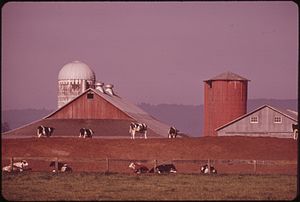
History
Dairy farming has been part of agriculture for thousands of years. Historically it has been one part of small, diverse farms. In the last century or so larger farms doing only dairy production have emerged. Large scale dairy farming is only viable where either a large amount of milk is required for production of more durable dairy products such as cheese, butter, etc. or there is a substantial market of people with cash to buy milk, but no cows of their own.
Hand milking
Centralized dairy farming as we understand it primarily developed around villages and cities, where residents were unable to have cows of their own due to a lack of grazing land. Near the town, farmers could make some extra money on the side by having additional animals and selling the milk in town. The dairy farmers would fill barrels with milk in the morning and bring it to market on a wagon. Until the late 19th century, the milking of the cow was done by hand. In the United States, several large dairy operations existed in some northeastern states and in the west, that involved as many as several hundred cows, but an individual milker could not be expected to milk more than a dozen cows a day. Smaller operations predominated.
For most herds, milking took place indoors twice a day, in a barn with the cattle tied by the neck with ropes or held in place by stanchions. Feeding could occur simultaneously with milking in the barn, although most dairy cattle were pastured during the day between milkings. Such examples of this method of dairy farming are difficult to locate, but some are preserved as a historic site for a glimpse into the days gone by. One such instance that is open for this is at Point Reyes National Seashore.
Vacuum bucket milking
The first milking machines were an extension of the traditional milking pail. The early milker device fit on top of a regular milk pail and sat on the floor under the cow. Following each cow being milked, the bucket would be dumped into a holding tank. This developed into the Surge hanging milker. Prior to milking a cow, a large wide leather strap called a surcingle was put around the cow, across the cow's lower back. The milker device and collection tank hung underneath the cow from the strap. This innovation allowed the cow to move around naturally during the milking process rather than having to stand perfectly still over a bucket on the floor.
Milking pipeline
The next innovation in automatic milking was the milk pipeline. This uses a permanent milk-return pipe and a second vacuum pipe that encircles the barn or milking parlor above the rows of cows, with quick-seal entry ports above each cow. By eliminating the need for the milk container, the milking device shrank in size and weight to the point where it could hang under the cow, held up only by the sucking force of the milker nipples on the cow's udder. The milk is pulled up into the milk-return pipe by the vacuum system, and then flows by gravity to the milkhouse vacuum-breaker that puts the milk in the storage tank. The pipeline system greatly reduced the physical labor of milking since the farmer no longer needed to carry around huge heavy buckets of milk from each cow.
The pipeline allowed barn length to keep increasing and expanding, but after a point farmers started to milk the cows in large groups, filling the barn with one-half to one-third of the herd, milking the animals, and then emptying and refilling the barn. As herd sizes continued to increase, this evolved into the more efficient milking parlor.
Milking parlors
Innovation in milking focused on mechanizing the milking parlor (known in Australia and New Zealand as a milking shed) to maximize the number of cows per operator which streamlined the milking process to permit cows to be milked as if on an assembly line, and to reduce physical stresses on the farmer by putting the cows on a platform slightly above the person milking the cows to eliminate having to constantly bend over. Many older and smaller farms still have tie-stall or stanchion barns, but worldwide a majority of commercial farms have parlors.
Herringbone and parallel parlors
In herringbone and parallel parlors, the milker generally milks one row at a time. The milker will move a row of cows from the holding yard into the milking parlor, and milk each cow in that row. Once all or most of the milking machines have been removed from the milked row, the milker releases the cows to their feed. A new group of cows is then loaded into the now vacant side and the process repeats until all cows are milked. Depending on the size of the milking parlor, which normally is the bottleneck, these rows of cows can range from four to sixty at a time.
Rotary parlors
In rotary parlors, the cows are loaded one at a time onto the platform as it slowly rotates. The milker stands near the entry to the parlor and puts the cups on the cows as they move past. By the time the platform has completed almost a full rotation, another milker or a machine removes the cups and the cow steps backwards off the platform and then walks to its feed. Rotary cowsheds, as they are called in New Zealand, started in the 1980s but are expensive compared to Herringbone cowshed - the older New Zealand norm. To justify the costs herds have got bigger with 1 person milking 500-600 cows. A rotary is about 25% faster than a herringbone shed for the same number of cows.
Automatic milker take-off
It can be harmful to an animal for it to be over-milked past the point where the udder has stopped releasing milk. Consequently the milking process involves not just applying the milker, but also monitoring the process to determine when the animal has been milked out and the milker should be removed. While parlor operations allowed a farmer to milk many more animals much more quickly, it also increased the number of animals to be monitored simultaneously by the farmer. The automatic take-off system was developed to remove the milker from the cow when the milk flow reaches a preset level, relieving the farmer of the duties of carefully watching over 20 or more animals being milked at the same time. This is a standard procedure in New Zealand
Fully automated robotic milking
In the 1980s and 1990s, robotic milking systems were developed and introduced (principally in the EU). Thousands of these systems are now in routine operation. In these systems the cow has a high degree of autonomy to choose her time of milking within pre-defined windows. These systems are generally limited to intensively managed systems although research continues to match them to the requirements of grazing cattle and to develop sensors to detect animal health and fertility automatically.
History of milk preservation methods
Cool temperature has been the main method by which milk freshness has been extended. When windmills and well pumps were invented, one of its first uses on the farm besides providing water for animals was for cooling milk, to extend the storage life before being transported to the town market.
The naturally cold underground water would be continuously pumped into a tub or other containers of milk set in the tub to cool after milking. This method of milk cooling was extremely popular before the arrival of electricity and refrigeration.
Refrigeration
When refrigeration first arrived (the 19th century) the equipment was initially used to cool cans of milk, which were filled by hand milking. These cans were placed into a cooled water bath to remove heat and keep them cool until they were able to be transported to a collection facility. As more automated methods were developed for harvesting milk, hand milking was replaced and, as a result, the milk can was replaced by a bulk milk cooler. 'Ice banks' were the first type of bulk milk cooler. This was a double wall vessel with evaporator coils and water located between the walls at the bottom and sides of the tank. A small refrigeration compressor was used to remove heat from the evaporator coils. Ice eventually builds up around the coils, until it reaches a thickness of about three inches surrounding each pipe, and the cooling system shuts off. When the milking operation starts, only the milk agitator and the water circulation pump, which flows water across the ice and the steel walls of the tank, are needed to reduce the incoming milk to a temperature below 5 degrees.
This cooling method worked well for smaller dairies, however was fairly inefficient and was unable to meet the increasingly higher cooling demand of larger milking parlors. In the mid-1950s direct expansion refrigeration was first applied directly to the bulk milk cooler. This type of cooling utilizes an evaporator built directly into the inner wall of the storage tank to remove heat from the milk. Direct expansion is able to cool milk at a much faster rate than early ice bank type coolers and is still the primary method for bulk tank cooling today on small to medium sized operations.
Another device which has contributed significantly to milk quality is the plate heat exchanger (PHE). This device utilizes a number of specially designed stainless steel plates with small spaces between them. Milk is passed between every other set of plates with water being passed between the balance of the plates to remove heat from the milk. This method of cooling can remove large amounts of heat from the milk in a very short time, thus drastically slowing bacteria growth and thereby improving milk quality. Ground water is the most common source of cooling medium for this device. Dairy cows consume approximately 3 gallons of water for every gallon of milk production and prefer to drink slightly warm water as opposed to cold ground water. For this reason, PHE's can result in drastically improved milk quality, reduced operating costs for the dairymen by reducing the refrigeration load on his bulk milk cooler, and increased milk production by supplying the cows with a source of fresh warm water.
Plate heat exchangers have also evolved as a result of the increase of dairy farm herd sizes in the United States. As a dairyman increases the size of his herd, he must also increase the capacity of his milking parlor in order to harvest the additional milk. This increase in parlor sizes has resulted in tremendous increases in milk throughput and cooling demand. Today's larger farms produce milk at a rate which direct expansion refrigeration systems on bulk milk coolers cannot cool in a timely manner. PHE's are typically utilized in this instance to rapidly cool the milk to the desired temperature (or close to it) before it reaches the bulk milk tank. Typically, ground water is still utilized to provide some initial cooling to bring the milk to between 55 and 70 °F (21 °C). A second (and sometimes third) section of the PHE is added to remove the remaining heat with a mixture of chilled pure water and propylene glycol. These chiller systems can be made to incorporate large evaporator surface areas and high chilled water flow rates to cool high flow rates of milk.
Milking operation
Milking machines are held in place automatically by a vacuum system that draws the ambient air pressure down from 15 to 21 pounds per square inch (100 to 140 kPa) of vacuum. The vacuum is also used to lift milk vertically through small diameter hoses, into the receiving can. A milk lift pump draws the milk from the receiving can through large diameter stainless steel piping, through the plate cooler, then into a refrigerated bulk tank.
Milk is extracted from the cow's udder by flexible rubber sheaths known as liners or inflations that are surrounded by a rigid air chamber. A pulsating flow of ambient air and vacuum is applied to the inflation's air chamber during the milking process. When ambient air is allowed to enter the chamber, the vacuum inside the inflation causes the inflation to collapse around the cow's teat, squeezing the milk out of teat in a similar fashion as a baby calf's mouth massaging the teat. When the vacuum is reapplied in the chamber the flexible rubber inflation relaxes and opens up, preparing for the next squeezing cycle.
It takes the average cow three to five minutes to give her milk. Some cows are faster or slower. Slow-milking cows may take up to fifteen minutes to let down all their milk. Milking speed is only minorly related to the quantity of milk the cow produces — milking speed is a separate factor from milk quantity; milk quantity is not determinative of milking speed. Because most milkers milk cattle in groups, the milker can only process a group of cows at the speed of the slowest-milking cow. For this reason, many farmers will group slow-milking cows so as not to stress the faster milking cows.
The extracted milk passes through a strainer and plate heat exchangers before entering the tank, where it can be stored safely for a few days at approximately 42 °F (6 °C). At pre-arranged times, a milk truck arrives and pumps the milk from the tank for transport to a dairy factory where it will be pasteurized and processed into many products.
Management of the herd
Modern dairy farmers use milking machines and sophisticated plumbing systems to harvest and store the milk from the cows, which are usually milked two or three times daily. In New Zealand some farmers seeking a better life style, are milking only once per day, trading a slight reduction in production of milk for increased leisure time. During the summer months, cows may be turned out to graze in pastures, both day and night, and are brought into the barn to be milked.
Barns may also incorporate tunnel ventilation into the architecture of the barn structure. This ventilation system is highly efficient and involves opening both ends of the structure allowing cool air to blow through the building. Farmers with this type of structure keep cows inside during the summer months to prevent sunburn and damage to udders. During the winter months the cows may be kept in the barn, which is warmed by their collective body heat. Even in winter, the heat produced by the cattle requires the barns to be ventilated for cooling purposes. Many modern facilities, and particularly those in tropical areas, keep all animals inside at all times to facilitate herd management.
Housing can be either loose in stalls (called cow cubicles in UK). There is little research available on dimensions required for cow stalls, and much housing can be out of date, however increasingly companies are making farmers aware of the benefits, in terms of animal welfare, health and milk production.
Farmers typically grow their own food for their cattle. This may include corn, and " hay", which includes alfalfa, timothy, and clover.
In the southern hemisphere such as in Australia and New Zealand, cows spend most of their lives outside on pasture, although they may receive supplementation during periods of low pasture availability. Typical supplementary feeds in Australasia are hay, silage or ground maize. The trend in New Zealand is towards feeding cows on a concrete pad to prevent loss of feed by trampling. In New Zealand slower growing winter pasture is rationed. It is carefully controlled by light weight portable electric break feeding fences run on mains power that can be easily repositioned.
Concerns
Animal waste from large dairies
As measured in phosphorus, the waste output of 5,000 cows roughly equals a municipality of 70,000 people. In the U.S., dairy operations with more than 1,000 cows meet the EPA definition of a CAFO (Concentrated Animal Feeding Operation), and are subject to EPA regulations. For example, in the San Joaquin Valley of California a number of dairies have been established on a very large scale. Each dairy consists of several modern milking parlor set-ups operated as a single enterprise. Each milking parlor is surrounded by a set of 3 or 4 loafing barns housing 1,500 or 2,000 cattle. Some of the larger dairies have planned 10 or more series of loafing barns and milking parlors in this arrangement, so that the total operation may include as many as 15,000 or 20,000 cows. The milking process for these dairies is similar to a smaller dairy with a single milking parlor but repeated several times. The size and concentration of cattle creates major environmental issues associated with manure handling and disposal, which requires substantial areas of cropland (a ratio of 5 or 6 cows to the acre, or several thousand acres for dairies of this size) for manure spreading and dispersion, or several-acre methane digesters. Air pollution from methane gas associated with manure management also is a major concern. As a result, proposals to develop dairies of this size can be controversial and provoke substantial opposition from environmentalists including the Sierra Club and local activists.
The potential impact of large dairies was demonstrated when a massive manure spill occurred on a 5,000-cow dairy in Upstate New York, contaminating a 20-mile (32 km) stretch of the Black River, and killing 375,000 fish. On Aug. 10, 2005, a manure storage lagoon collapsed releasing 3,000,000 US gallons (11,000,000 l; 2,500,000 imp gal) of manure into the Black River. Subsequently the New York Department of Environmental Conservation mandated a settlement package of $2.2 million against the dairy.
When properly managed, dairy and other livestock waste, due to its nutrient content (N, P, K), makes an excellent fertilizer promoting crop growth, increasing soil organic matter, and improving overall soil fertility and tilth characteristics. Most dairy farms in the United States are required to develop nutrient management plans for their farms, to help balance the flow of nutrients and reduce the risks of environmental pollution. These plans encourage producers to monitor all nutrients coming onto the farm as feed, forage, animals, fertilizer, etc. and all nutrients exiting the farm as product, crop, animals, manure, etc. For example, a precision approach to animal feeding results in less overfeeding of nutrients and a subsequent decrease in environmental excretion of nutrients, such as phosphorus. In recent years, nutritionists have realized that requirements for phosphorus are much lower than previously thought. These changes have allowed dairy producers to reduce the amount of phosphorus being fed to their cows with a reduction in environmental pollution.
In New Zealand the average dairy farmer has 500 cows which are milked twice per day taking about 2 hours per milking. All cows are grazed on grass pasture. Dung and urine from the milking shed is flushed into drains by large high pressure hoses, which lead to open pits. Over time the solid matter settles to the bottom and is removed by truck about once per year. The relatively clean water is allowed to percolate through natural swamp and creeks back to major rivers. Local authorities check that water entering rivers meets minimum standards. Farmers are fined and forced to change their systems to meet the standards. Repeated infringement means the farm is closed down. Local councils often supply large numbers of native swamp plants grown in their own nurseries to farmer at a low cost. Planting is also done by environmental groups, and schools as part of their science program and groups of unemployed on relief work.
Use of hormones
It is possible to maintain higher milk production by injecting cows with growth hormones known as recombinant BST or rBST, but this is controversial due to its effects on animal and possibly human health. The European Union, Japan, Australia, New Zealand and Canada have banned its use due to these concerns.
In the US however, no such prohibition exists, and approximately 17.2% of dairy cows are treated in this way. The U.S. Food and Drug Administration states that no "significant difference" has been found between milk from treated and non-treated cows but based on consumer concerns several milk purchasers and resellers have elected not to purchase milk produced with rBST.
Animal welfare
The practice of dairy production in a factory farm environment has been criticized by animal rights activists. Some of the ethical complaints regarding dairy production cited include how often the dairy cattle must remain pregnant, the separation of calves from their mothers, how dairy cattle are housed and environmental concerns regarding dairy production.
The production of milk requires that the cow be in lactation, which is a result of the cow having given birth to a calf. The cycle of insemination, pregnancy, parturition, and lactation, followed by a "dry" period of about two months of forty-five to fifty days, before calving which allows udder tissue to regenerate. A dry period that falls outside this time frames can result in decreased milk production in subsequent lactation. Dairy operations therefore include both the production of milk and the production of calves. Bull calves are either castrated and raised as steers for beef production or veal.
An important part of the dairy industry is the removal of the calves off the mother’s milk after the three days of needed colostrum, allowing for the collection of the milk produced. In order for this to take place, the calves are fed milk replacer, a substitute for the whole milk produced by the cow. Milk replacer is generally a powder, which comes in large bags, and is added to precise amounts of water, and then fed to the calf via bucket or bottle.
Milk replacers are classified by three categories: protein source, protein/fat (energy) levels, and medication or additives (e.g. vitamins and minerals). Proteins for the milk replacer come from different sources; the more favorable and more expensive all milk protein (e.g. whey protein- a bi product of the cheese industry) and alternative proteins including soy, animal plasma and wheat gluten. The ideal levels for fat and protein in milk replacer are 10-28% and 18-30%, respectively. The higher the energy levels (fat and protein), the less starter feed (feed which is given to young animals) the animal will consume. Weaning can take place when a calf is consuming at least two pounds of starter feed a day and has been on starter for at least three weeks. Milk replacer has climbed in cost US$15–20 a bag in recent years, so early weaning is economically crucial to effective calf management.
Because of the danger of infection to humans, it is important to maintain the health of milk-producing cattle. Common ailments affecting dairy cows include infectious disease (e.g. mastitis, endometritis and digital dermatitis), metabolic disease (e.g. milk fever and ketosis) and injuries caused by their environment (e.g. hoof and hock lesions).
Lameness is commonly considered one of the most significant animal welfare issues for dairy cattle, and is best defined as any abnormality that causes an animal to change its gait. It can be caused by a number of sources, including infections of the hoof tissue (e.g. fungal infections that cause dermatitis) and physical damage causing bruising or lesions (e.g. ulcers or hemorrhage of the hoof). Housing and management features common in modern dairy farms (such as concrete barn floors, limited access to pasture and suboptimal bed-stall design) have been identified as contributing risk factors to infections and injuries.
Market
Worldwide
There is a great deal of variation in the pattern of dairy production worldwide. Many countries which are large producers consume most of this internally, while others (in particular New Zealand), export a large percentage of their production. Internal consumption is often in the form of liquid milk, while the bulk of international trade is in processed dairy products such as milk powder.
Most milk-consuming countries have a local dairy farming industry, and most producing countries maintain significant tariffs to protect domestic producers from foreign competition but, the largest dairy exporting country, does not apply any subsidies to dairy production.
The milking of cows was traditionally a labor-intensive operation and still is in less developed countries. Small farms need several people to milk and care for only a few dozen cows, though for many farms these employees have traditionally been the children of the farm family, giving rise to the term " family farm".
Advances in technology have mostly led to the radical redefinition of "family farms" in industrialized countries such as Australia, New Zealand, and the United States. With farms of hundreds of cows producing large volumes of milk, the larger and more efficient dairy farms are more able to weather severe changes in milk price and operate profitably, while "traditional" very small farms generally do not have the equity or cash flow to do so. The common public perception of large corporate farms supplanting smaller ones is generally a misconception, as many small family farms expand to take advantage of economies of scale, and incorporate the business to limit the legal liabilities of the owners and simplify such things as tax management.
Before large scale mechanization arrived in the 1950s, keeping a dozen milk cows for the sale of milk was profitable. Now most dairies must have more than one hundred cows being milked at a time in order to be profitable, with other cows and heifers waiting to be "freshened" to join the milking herd . In New Zealand the average herd size, for the 2009/2010 season, is 376 cows.
Worldwide, the largest milk producer is the European Union with its present 27 member countries, with more than 153,000,000 metric tons (151,000,000 long tons; 169,000,000 short tons) in 2009 (more than 95% cow milk). By country, the largest producer is India (more than 55% buffalo milk), the largest cow milk exporter is New Zealand, and the largest importer is China.
| Rank | Country | Production (106 kg/y) |
|---|---|---|
| World | 696,554 | |
| 1 | 110,040 | |
| 2 | 85,859 | |
| 3 | 40,553 | |
| 4 | 34,362 | |
| 5 | 32,562 | |
| 6 | 28,691 | |
| 7 | 27,716 | |
| 8 | 24,218 | |
| 9 | 15,217 | |
| 10 | 13,237 | |
| 11 | 12,836 | |
| 12 | 12,542 | |
| 13 | 12,467 | |
| 14 | 11,610 | |
| 15 | 11,469 | |
| 16 | 10,931 | |
| 17 | 10,500 | |
| 18 | 9,388 | |
| 19 | 8,213 | |
| 20 | 7,909 |
European Union
The European Union with its present 27 member countries is the largest milk producer in the world. The largest producers within the EU are Germany and France.
Dairy production in the EU is heavily distorted due to the Common Agricultural Policy – being subsidized in some areas, and subject to production quotas in other.
| Rank | Country | Production (106 kg/y) |
|---|---|---|
(all 27 countries) |
153,033 | |
| 1 | 28,691 | |
| 2 | 24,218 | |
| 3 | 13,237 | |
| 4 | 12,836 | |
| 5 | 12,467 | |
| 6 | 11,469 | |
| 7 | 7,252 | |
| 8 | 5,809 | |
| 9 | 5.373 | |
| 10 | 4,814 |
Israel
The dairy farm on Sa'ad was the Israeli leader in 2011 for productivity with an average of 13,785 litres (3,032 imp gal; 3,642 US gal) per head that year. A dairy cow named Kharta, was the world record holder giving 18,208 litres (4,005 imp gal; 4,810 US gal) liters of milk. The 954 Israeli dairy farms achieved a world leading average production of 11,775 litres (2,590 imp gal; 3,111 US gal) a year per head, while the national average per head was 10,336 litres (2,274 imp gal; 2,730 US gal). Israeli consumption is lower than other western countries with an average of 180 litres (40 imp gal; 48 US gal) per person.
United States
In the United States, the top five dairy states are, in order by total milk production; California, Wisconsin, Idaho, New York and Pennsylvania. Dairy farming is also an important industry in Florida, Minnesota, Ohio and Vermont. There are 65,000 dairy farms in the United States.
Pennsylvania has 8,500 farms with 555,000 dairy cows. Milk produced in Pennsylvania yields an annual revenue of about US$1.5 billion.
Milk prices collapsed in 2009. Senator Bernie Sanders accused Dean Foods of controlling 40% of the country's milk market. He has requested the United States Department of Justice to pursue an anti-trust investigation. Dean Foods says it buys 15% of the country's raw milk. In 2011, a federal judge approved a settlement of $30 million to 9,000 farmers in the Northeast.
Herd size in the US varies between 1,200 on the West Coast and Southwest, where large farms are commonplace, to roughly 50 in the Northeast, where land-base is a significant limiting factor to herd size. The average herd size in the U.S. is about one hundred cows per farm.
